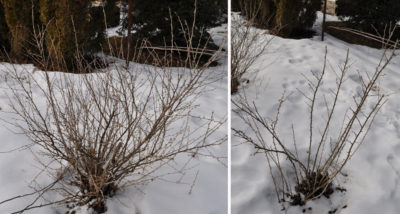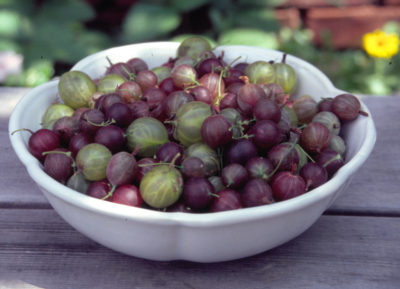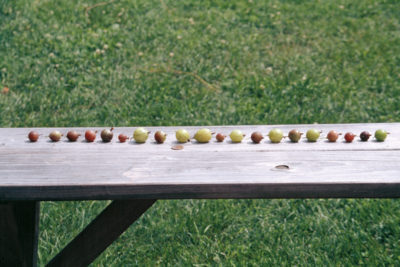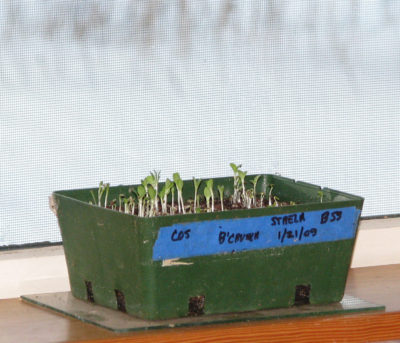THE WEATHER WON’T PUSH ME AROUND
Breaking (Pruning) Rules
Snow squall or not, I just had to get outside. Not enough snow for a cross-country ski, but, after too much time indoors, I had to do something outside.
I was driven to break a fundamental rule of the garden. I pruned, and that’s a no-no. Pruning is best delayed until at least after the coldest part of winter is over, ideally closer to the time when warmth and sun are stirring buds to swell in preparation for their final burst. I did rationalize that any pruning now would leave me that much less to do amidst the hubbub of spring gardening activities.
I wasn’t indiscriminate in trespassing this Rule of Gardening. The plants that I pruned were gooseberries, which are very cold-hardy plants so are unlikely to suffer any cold damage as a result of untimely pruning. Also, no need to wait, as is done with peaches, for growth to begin to see which branches have died back from winter cold; none ever do so on a gooseberry bush.
Pruning without spring breathing down my back made for a very relaxed pruning session. I had plenty of time to pay attention to details and prune a little differently than in the past.
Gooseberries bear fruits on stems that are 1-, 2-, and 3-years-old, so the usual method of pruning is to cut away any stems more than 3-years-old and remove all but six of the sturdiest 1-year-old stems. The pruned bush, then, is left with a half-dozen each of 1-, 2-, and 3-year old stems. Each year a bush is renewed as oldest stems are removed, and new grow kept vigorous and healthy as excess young stems are thinned out.

Gooseberry before & after pruning
The gooseberry bushes always bear many more berries than we can eat, and their weight bows the branches to the ground. So this year I decided to also prune each side branch on the older stems back to a couple of inches long. I’ll reap fewer berries, but those that remain should be larger and more accessible among the thorny stems.
Great Gooseberries
Is it worth mentioning such details about growing gooseberries? After all, who eats gooseberries these days? To most people, a gooseberry is a small, green, tart berry suitable only for pies, jams, and fools (a dessert made by folding cooked, sweetened, sieved gooseberries into whipped cream).
If small, green, and tart is your idea of a gooseberry, you’ve never tasted a so-called dessert gooseberry. Dessert gooseberries are sweet and flavorful right off the bush; they are, as Edward Bunyard wrote almost a hundred years ago in The Anatomy of Dessert, “the fruit par excellence for ambulant consumption.” (He was from England, where gooseberries are more appreciated and known than here.)
Only certain gooseberry varieties warrant the label “dessert gooseberry,’ of which I grow about a dozen varieties. My favorites include Hinonmakis Yellow, Poorman, Black Satin, Webster, Red jacket, and Captivator. Their sweet flavors carry wine-y overtones and reminiscences of plum or apricot. Some have soft skins, others have firm skins that explode with the flavorful, sweet juice when you bite into them. I devote a whole chapter to the history and varieties of gooseberries as well as how to grow them and where to get them in my book Uncommon Fruits for Every Garden (available from the usual sources and, from me and signed, at my website).
Back Indoors, But Still Gardening
Frozen fingertips eventually drove me back indoors. But I’m now on a gardening roll, spurred on further by a box of seed packets that arrived in the mail.
Lettuce, claytonia, and celery from the greenhouse have been filling our salad bowls all winter. As these plants wane or go to seed, we’ll need more. So today I sowed seeds of Black-Seeded Simpson, Romaine, Buttercrunch, Blushed Butter Cos, and Majestic Red lettuces. Some I sprinkled into seed flats that can be kept warm for quick germination. Some I sowed right in the ground beds in the greenhouse; they’ll germinate more slowly but hold their quality longer than those that are pricked out from seed flats into “cells” and then into the garden.
Sometime soon, I’ll grab my pruning shears and get back to the gooseberries. And then on to the grapes, the kiwis, the apples, the pears, the . . .



I’m not clear on why pruning is best left until after the coldest part of the winter has passed. Is dormancy not dormancy? Could you clarify?
Thanks
Probably just because “healing” of wound will begin sooner the later the cut is made.Also, dormancy is dormancy but there may be some small amount of cellular activity in response to a cut. I’m not sure how well this advice has been tested. My guess is that when you prune might not matter as long as the plant is dormant.
So how does one identify 1, 2 and 3 year-old wood? Do you label each branch with the year? This is a common recommendation for pruning but how can you tell the age of the wood?
Older stems are thicker and their bark is more peeling, usually, that is, they look older. You don’t have to be too, too exacting.
Love the gardening talk in the midst of winter… totally pouring buckets everyday in the PNW. Dreaming of spring……